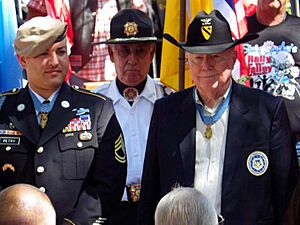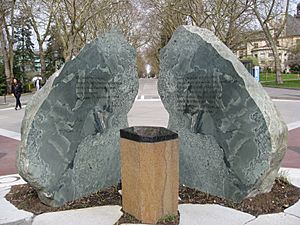Bruce P. Crandall facts for kids
Quick facts for kids
Bruce P. Crandall
|
|
|---|---|
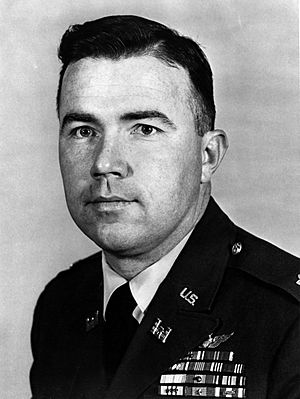
Crandall in the mid-1960s
|
|
| Nickname(s) | "Snake", "Snakeshit" |
| Born | February 17, 1933 Olympia, Washington |
| Allegiance | United States |
| Service/ |
United States Army |
| Years of service | 1953–1977 |
| Rank | Colonel |
| Battles/wars | Operation Power Pack Vietnam War
|
| Awards | Medal of Honor Distinguished Flying Cross (4) Bronze Star Medal Purple Heart Meritorious Service Medal (3) Air Medal (23) |
| Spouse(s) |
Arlene Shaffer
(m. 1956; died 2010) |
| Relations | 3 children, 5 grandchildren |
| Other work | City Manager of Dunsmuir, California Public Works Manager of Mesa, Arizona |
Bruce Perry Crandall is a retired officer from the United States Army. He was born on February 17, 1933. He earned the Medal of Honor for his brave actions as a helicopter pilot during the Battle of Ia Drang in South Vietnam. This important battle happened on November 14, 1965.
During the battle, Crandall flew 22 dangerous missions. He flew his Bell Huey helicopter into areas where enemies were shooting. He helped to rescue over 70 wounded soldiers. He also brought important supplies and ammunition to the American forces. His bravery in the Ia Drang Valley was shown in the movie We Were Soldiers, where actor Greg Kinnear played him. By the end of the Vietnam War, he had flown more than 900 combat missions. He retired from the army as a lieutenant colonel. He later worked in different jobs before settling down in Washington, his home state. Bruce Crandall lives in Tempe, Arizona.
Contents
Early Life and Family
Bruce Crandall was born in 1933 and grew up in Olympia, Washington. Olympia is the capital city of Washington state. He went to public schools there. In high school, he was a very good baseball player. He was even named an All-American player.
Crandall went to the University of Washington in Seattle. In 1953, he joined the United States Army. This was during the Korean War. On March 31, 1956, Crandall married Arlene Shaffer. They had three sons and five grandchildren. Arlene passed away on November 2, 2010.
Military Service and Missions
Crandall finished Engineer Officer Candidate School in 1954. He then trained to fly both fixed-wing planes and helicopters. His first job was with an Army Aviation mapping group. This group was based in San Francisco. It was the biggest flying military aviation unit in the world at that time.
He started by flying planes like the Cessna L-19 Bird Dog in Alaska. He helped with military mapping studies there. His first mission outside the United States was in Tripoli, Libya. For two years, he mapped the desert. He flew different types of aircraft as an instructor pilot.
Developing Air Tactics
Crandall's next missions were in Central and South America. He flew over many mountains and jungles that had never been mapped before. He was based at Howard Air Force Base in Panama. He helped create new ways to use helicopters in battle. These were called air-assault tactics.
In early 1965, he joined a special force in the Dominican Republic. Later that year, he went to South Vietnam. The United States was helping South Vietnam in a civil war against North Vietnam. Crandall led a helicopter unit called Company A, 229th Assault Helicopter Battalion. They were based at Camp Radcliff, Vietnam. His call sign was "Ancient Serpent 6."
Heroism at Ia Drang
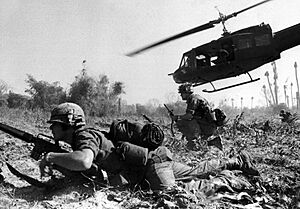
On November 14, 1965, Crandall led a big operation in the Battle of Ia Drang. He landed soldiers from the 1st and 2nd Battalions into a place called Landing Zone X-Ray. A very intense battle started. Crandall and his wingman, Major Ed Freeman, were incredibly brave.
They helped evacuate about 70 wounded soldiers. They made 12 to 18 flights even though the Medevac unit refused to land. This was because the landing zone was under heavy enemy fire. Crandall flew for over 16 hours that day. He said it was the longest day he ever spent flying. He had to use several helicopters because each one got badly damaged.
Crandall and Freeman also brought in much-needed ammunition. Their helicopters were not armed. Crandall first received the Distinguished Service Cross. This award was later upgraded to the Medal of Honor. President George W. Bush presented it to him on February 26, 2007.
Bravery in Operation Masher
On January 31, 1966, Crandall had just finished a long day of flying. He was supporting soldiers during an operation called "Operation Masher." He was about to stop for the night when he heard that 12 wounded soldiers needed help. They were trapped by heavy enemy fire.
Crandall quickly refueled his helicopter. He flew to the area even though it was very dark. The pick-up zone was surrounded by trees. The Medevac unit had refused to land there. Crandall decided to land his helicopter straight down to avoid the trees. He did not use his lights so the enemy wouldn't see them. He asked his friend, Captain Tony Nadal, to point a flashlight up. Crandall landed twice under heavy enemy fire. He successfully rescued all 12 wounded soldiers.
Later Military Assignments
After an assignment in Colorado, Crandall went to the Armed Forces Staff College. Soon after, he returned to South Vietnam. This time, he flew UH-1 Huey gunships. He supported the 1st Battalion, 9th Cavalry Squadron.
In January 1968, Crandall's helicopter was shot down during another rescue. He spent five months in the hospital. He recovered from a broken back and other injuries. He then studied at the University of Nebraska and graduated in 1969. He later worked in Bangkok, Thailand, managing 3,800 people. He also served at Fort Leonard Wood, Missouri.
Crandall was going to be an adviser in Argentina. He and his wife, Arlene, learned Spanish for this. But Crandall had a stroke, which ended his flying career. After recovering, he worked for the Defense Mapping Agency in Venezuela. His last army job was as a senior engineer adviser in California. In 1977, he retired from the army as a lieutenant colonel.
Life After the Army
After retiring from the army, Crandall earned a master's degree in 1977. He then worked in public service jobs. He was the city manager of Dunsmuir, California, for three years. Later, he and his wife moved to Mesa, Arizona. He worked for 17 years in the Public Works Department. His wife, Arlene, passed away in 2010 and is buried at Arlington National Cemetery.
On April 15, 2010, Crandall was promoted to colonel. This was more than 30 years after he retired. It was to recognize his achievements and receiving the Medal of Honor. He has attended many events honoring veterans. He even raised the "12th Man" flag for the Seattle Seahawks football team in 2013.
Awards and Honors
Crandall has received many military awards for his bravery.
 |
|||||
| Master Army Aviator Badge | |||||||||||
| Medal of Honor | Distinguished Flying Cross w/ 3 bronze oak leaf clusters |
||||||||||
| Bronze Star Medal | Purple Heart | Meritorious Service Medal w/ 2 bronze oak leaf clusters |
|||||||||
| Air Medal w/ award numeral 23 |
Army Commendation Medal | Army Good Conduct Medal | |||||||||
| National Defense Service Medal w/ 1 bronze service star |
Armed Forces Expeditionary Medal | Vietnam Service Medal w/ 4 bronze campaign stars |
|||||||||
| Armed Forces Reserve Medal | Vietnam Cross of Gallantry w/ Palm and 3 Gold Stars |
Republic of Vietnam Campaign Medal | |||||||||
| Army Presidential Unit Citation | Valorous Unit Award | ||||||||||
| Meritorious Unit Commendation | Vietnam Gallantry Cross Unit Citation | Vietnam Civil Actions Unit Citation | |||||||||
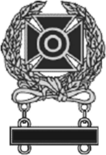 |
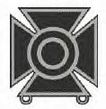 |
| Army Expert Marksmanship Badge | Army Sharpshooter Badge |
Medal of Honor Details
On February 26, 2007, President George Bush gave Crandall the Medal of Honor. This was for his actions during the Battle of Ia Drang.
The award citation describes his amazing bravery. On November 14, 1965, he led 16 helicopters to drop off troops. The landing zone came under heavy enemy fire. Crandall's helicopter was unarmed. He decided to fly back to get more ammunition for the soldiers. He also wanted to evacuate wounded soldiers.
Even though it was not his main job, he found volunteers. He led two helicopters back into the dangerous landing zone. He landed and helped load seriously wounded soldiers. His brave decision inspired other pilots to keep landing their aircraft. It also showed the soldiers on the ground that they would get help. This greatly boosted their spirits during a very difficult time. Crandall made 22 flights that day. Most were under intense enemy fire. He only left the battlefield after helping as much as he could. His actions were crucial for getting supplies and evacuating the wounded.
Other Recognitions
Crandall has received many other honors. In 1994, he was inducted into the United States Air Force's "Gathering of Eagles." He was one of only seven Army aviators to receive this honor. In 2004, he was inducted into the Army Aviation Hall of Fame.
For his courage during Operation Masher, Crandall received the Aviation & Space Writers Helicopter Heroism Award in 1966. His rescue flights were ranked as the best in the first 20 years of the award. The baseball field at Olympia High School was named after him in 2003. Crandall was a great baseball player there. He also served as the honorary starter for the 2011 Indianapolis 500 race.
Crandall's story is told in the 1992 book We Were Soldiers Once...And Young. It was also shown in the 2002 movie We Were Soldiers. He even worked as an aviation consultant for the movie in 2001.
University of Washington Memorial
There is a special memorial at the University of Washington. It honors alumni who received the Medal of Honor. This memorial was built in 2009. It honors Bruce Crandall and other brave individuals.
See also
 In Spanish: Bruce Crandall para niños
In Spanish: Bruce Crandall para niños
- List of Medal of Honor recipients for the Vietnam War
- List of University of Washington people
- List of Golden Gate University people


